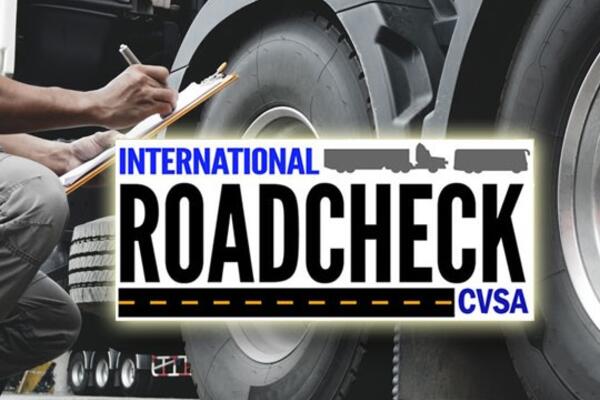International Roadcheck Set for May 4-6 with Emphasis on Lighting and Hours of Service

The Commercial Vehicle Safety Alliance (CVSA) has set May 4-6 as the dates for this year’s International Roadcheck. Over that 72-hour period, commercial motor vehicle inspectors in jurisdictions throughout Canada, Mexico and the U.S. will conduct inspections on commercial motor vehicles and drivers.
Each year, CVSA asks its member jurisdictions to capture and report data focusing on a certain category of violations during International Roadcheck. This helps bring awareness to certain aspects of a roadside inspection. This year, inspectors will capture data on two categories, corresponding to the two main inspection categories of the North American Standard Level I Inspection – driver operating requirements and vehicle mechanical fitness. For the driver category, hours of service will be highlighted this year, and for the vehicle category, inspectors will be paying special attention to lighting.
According to the Federal Motor Carrier Safety Administration, the lighting violation “lamps inoperable” (Title 49 Code of Federal Regulations 393.9) was the number one vehicle violation in fiscal 2020, accounting for approximately 12.24% of all vehicle violations discovered that year. And during last year’s International Roadcheck, the top driver out-of-service violation category in North America was hours of service, accounting for 34.7% of all driver out-of-service conditions.
Learn more about International Roadcheck.
Commercial Vehicle Safety Alliance (CVSA) Driver Tip Sheet
CVSA published this tip sheet for carriers and drivers in preparation for this year’s Roadcheck that you can print off as a handout for your drivers.
Question of the Week: My driver has gone through a roadside inspection, how long do I have to keep this documentation on file?
Answer: Copies of all roadside inspections are to be kept by the motor carrier for 12 months. The driver is required to turn in the inspection to the motor carrier within 24 hours. If they are not going to return to the terminal they are to mail in the inspection. If the inspection resulted in violations they are to be corrected or repaired and the inspection form is to be signed and certified that the repairs were completed and sent back to the state of inspection within 15 days.
Best Practice Guidelines for Roadside Inspections
- Train drivers how to complete good quality pre-trip inspection to reduce possibility of violations.
- Use Idealease Pre-Post Trip training videos:
English:
Spanish:
- Review your FMCSA data monthly at https://safer.fmcsa.dot.gov/CompanySnapshot.aspx and enter your DOT number or name.
- After reviewing the snapshot report click on the SMS (CSA) link in the blue box in the upper right hand corner.
- Review the vehicle and driver basics with the associated inspections and cross reference the inspections you have on file with the inspections turned in by your drivers. Question those drivers who did not submit inspection reports.
- Review the “Carrier History” tab in the Tools/Resource section on your home page to determine if the number of inspections you are having is on the rise or decline.
- Review vehicle inspections and violations with your maintenance provider to reduce violations.
- Maintain copies, along with any repair orders attached if there were violations, in tractor and trailer file.
- Use the roadside inspection information, such as date, time and locations to cross reference with the drivers hours of service documentation for falsification violations.
- Train drivers how to successfully pass a roadside inspections and how to conduct themselves.
- Keep your vehicles clean and well maintained as not to be targeted for inspection.
- Advise drivers that moving violations will generate inspections.
- Consider providing an incentive to drivers who successfully pass an inspection.
Senators Reintroduce DRIVE Safe Act
Senator Todd Young (R-IN) and a bipartisan group of seven other Senators have reintroduced the “Developing Responsible Individuals for a Vibrant Economy Act” or “DRIVE Safe Act,” in the Senate. The bill would allow 18-20 year-olds to drive commercial motor vehicles in interstate commerce under certain safeguards and conditions.
The bill, which was first introduced in the last Congress, would require completion of two separate apprenticeships before a driver under 21 years of age could drive a CMV in interstate commerce.
The first apprenticeship would require a minimum of 120 on-duty hours, with at least 80 hours behind the wheel of a CMV accompanied by an experienced driver. The apprentice would have to pass established performance benchmarks, including: interstate, city traffic, rural 2-lane, and evening driving; safety awareness; speed and space management; lane control; mirror scanning; right and left turns; and logging and complying with rules relating to hours of service.
The second apprenticeship would require a minimum of 280 on-duty hours, with at least 160 hours behind the wheel of a CMV. The apprentice would have to pass additional performance benchmarks, including: backing and maneuvering in close quarters; pre-trip inspections; fueling procedures; weighing loads, weight distribution, and sliding tandems; coupling and uncoupling procedure; and trip planning, truck routes, map reading, navigation, and permits.
Download PDF

